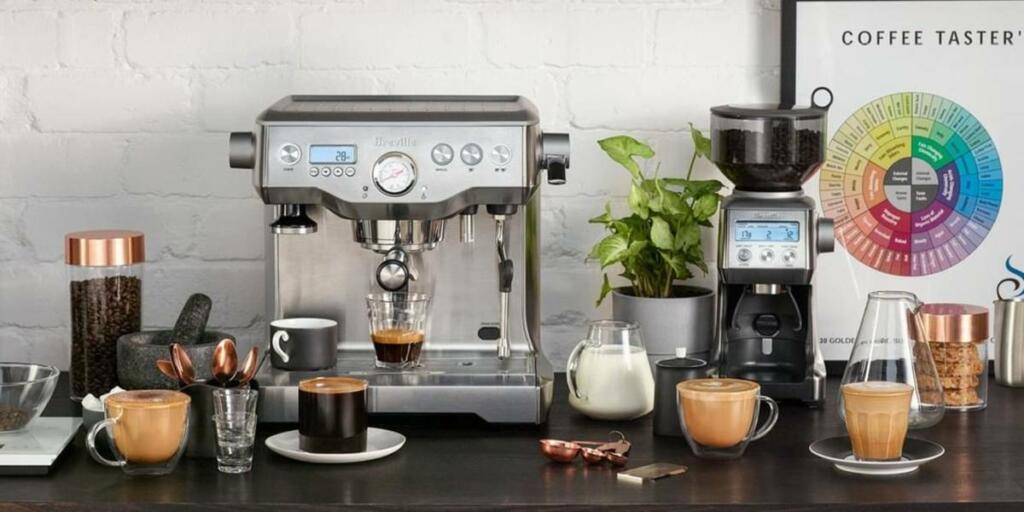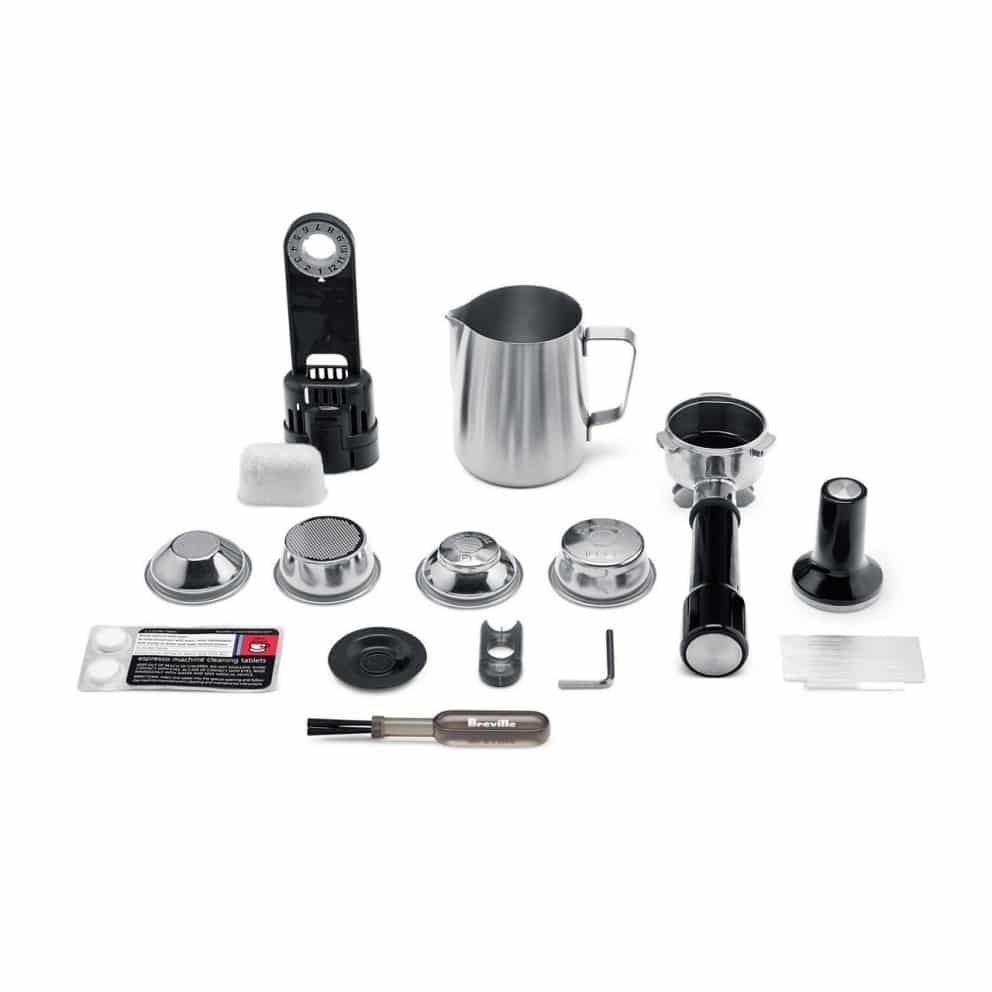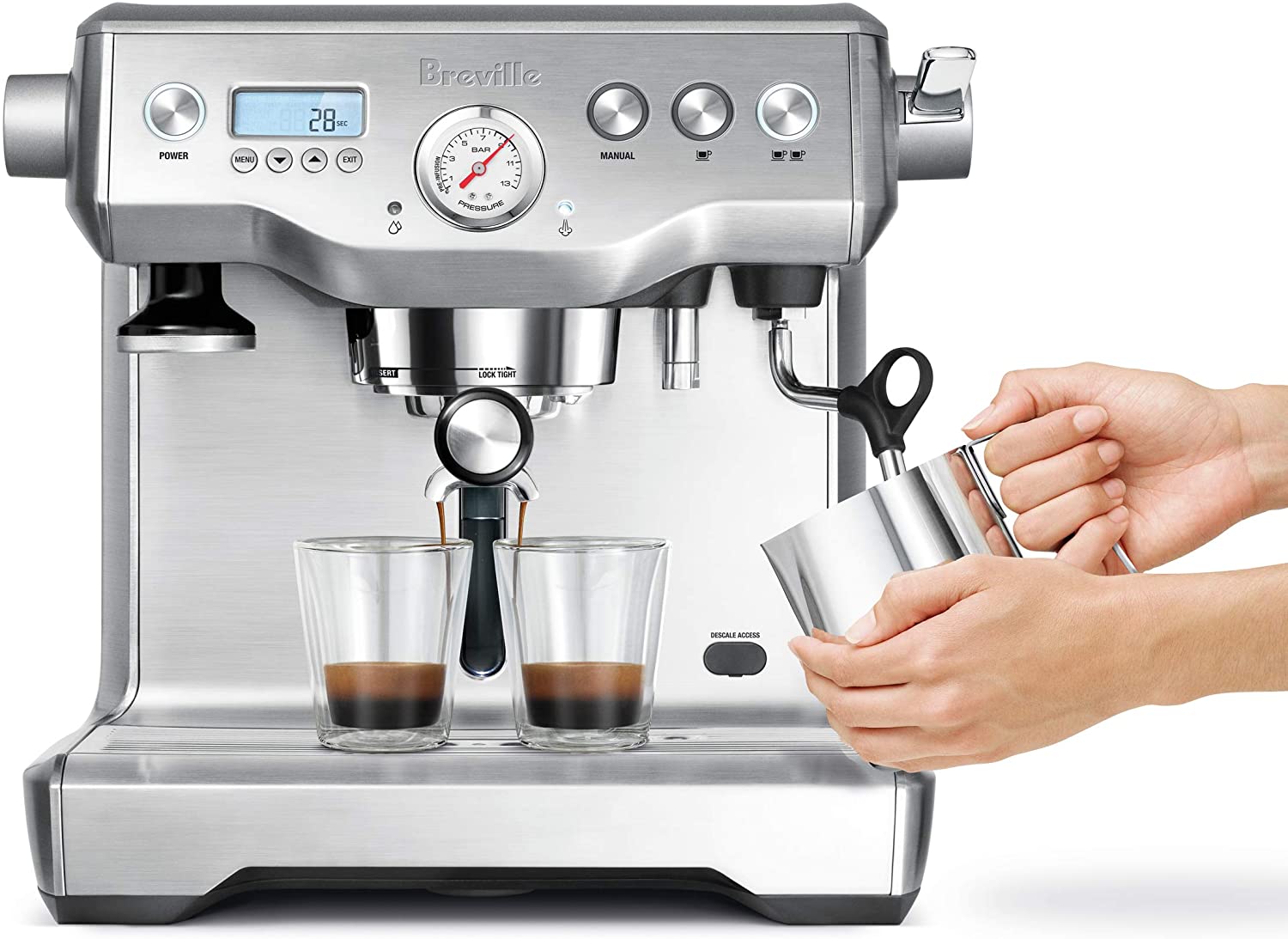One name in the world of espresso machines is easily recognized everywhere – Breville. However, even if we disregard their previous models (all of which were successes), the recent Breville BES920XL Dual Boiler model is a product in which the company excelled.
Its programmability options, pre-infusion, dual boilers, absolutely stunning appearance, and reasonable price point make it one of the most popular espresso machines.

If you’re still not convinced, let us take deeper into the model’s core.
The Dual Boiler Espresso Machine by Breville, BES920XL
To get this out of the way, there are some differences between this model and the previous one (BES900XL). The BES920XL machine, for example, allows you to drain the boiler on your own.
The dual boilers inside are its most prominent selling point. That is usually common, but not in that price range and, more importantly, not by a top-quality manufacturer. The BES920XL has features that you would not normally find in this price range, such as programmability options, but it also has classic middle-class features, such as dual boilers, pre-infusion, and so on.
- Dual Italian pumps and dual stainless steel boilers for espresso extraction and steaming at the same time
- Backlit LCDs display the shot clock, brew temperature, and time. We suggest that you use cold, filtered water. We do not advise using water with little or no mineral content.
- Electronic PID temperature control ensures accurate water temperature.
- It comes with a descale alert, a water hardness test strip, and an LCD-aided descale procedure.
The boiler’s most important feature is that it is made of stainless steel. This is because you want these materials in your espresso machine and brass (you would not want the boiler to be made from aluminum).
What’s incredible about this is that stainless steel boilers in coffee machines usually cost at least twice as much as this one. This feature may be the only justification you need to buy this thing, but there are a few more that will solidify your decision.
The heated group head is another feature typically found on much more expensive machines. We won’t detail this feature, but we will say that Breville chose the E61 heated group head.
It’s a little out of date in terms of technology, but it’s also the most dependable and well-built group head on the market right now, and its biggest advantage is that it’s heated.
Breville’s amazing features
The LED screen on the BES920XL will make your life easier. It gives you direct access to the boiler’s status (such as temperature and readiness). We’re not saying this is vital because even the most expensive machines lack it, but it’s still nice to have. Dual heat exchangers are used to controlling the temperature.
This enables you to brew any coffee while also steaming milk. The dual boilers will perform whatever function you assign to them. For example, one will handle the steaming while the other handles the espresso shot. Regarding steaming, we suggest buying this frothing pitcher to help you out.
All of this adds unprecedented consistency, putting BES920XL ahead of the competition.
Finally, after reviewing most of the user comments on the internet, we discovered that the style, the amazing consistency, how easy it is to use, the fact that there is really no better coffee machine in this price range, and perhaps most importantly – that you get all that you will need straight out of the box are the most popular features. A tamper, a dosing tool, a milk steaming pitcher, extra baskets, and other accessories are included.
Accessories

Breville includes two pairs of single/double baskets, catering to experienced and novice espresso enthusiasts. Standard baskets are one pair, and restricted (pressurized) baskets are the other.
The last basket makes the best of stale or overly coarsely ground coffee and is avoided by more seasoned baristas.
Breville also includes a tamper, which stores in a slot next to the group head thanks to a magnet on the top of the tamper handle. Breville is unique among espresso machine manufacturers in that it includes all the accessories you need to get started.
Dual boilers
An ideal espresso maker must deliver water to a puck of ground coffee at an optimal pressure of 9 bars while maintaining a steady, stable temperature. With its fantastic dual stainless steel boiler system, the BES920XL attains this combination.
Two separate boilers, the Steam Boiler and the Espresso Boiler work together to provide instant and powerful steam on-demand and the perfect espresso shot.
- The Espresso Boiler is PID temperature controlled, ensuring that each espresso shot is delivered at the optimal temperature and flavor.
- The Steam Boiler temperature is manually controlled through a digital menu, producing powerful steam to produce cafe-quality steamed milk.
In addition to these two heating systems, a third heating system is designed inside the group head to ensure that all of the ingredients passing through are kept at a consistent temperature. This three-tiered heating system produces excellent brew temperature stability and a quick warmup time. Breville recommends waiting 15 minutes before starting the brewing process to allow the machine to warm up properly.
Brew temperature
The capacity to deliver water to a puck of ground coffee at 9 bars of pressure and a consistent, relatively stable temperature is at the heart of any espresso machine. Cappuccino enthusiasts value the ability to produce latte-art quality microfoam as well. The Breville Dual Boiler exceeds expectations in every way.
The BDB has three different heating systems, as shown in the diagram below (courtesy of Breville):
- 900W steam boiler heater,
- 700W brew boiler heater,
- and a 100W group head heater.
In the steam boiler, water is heated to steam temperature. The temperature can be changed using the digital menu. Brew water is preheated to avoid temperature fluctuations caused by cold water injection by circumventing a portion of its inlet tubing via the (stainless steel) steam boiler before reaching the (stainless steel) brew boiler. In addition, the group head has a heating coil (#3), which improves temperature stability even further.
Heating elements in the steam boiler (#1), brew boiler (#2), and group head (#3)
This “hat trick” of heating systems results in outstanding brew temperature stability and extremely fast warmup times. The brew boiler’s and group head heater’s electronic temperature controllers precisely achieve the expected brew temperature. Breville recommends waiting 15 minutes for the system to warm up after a cold start; I did find this to be more than sufficient.
The Breville Dual Boiler is outfitted with two vibe pumps: a 4.5 bar Ceme (for filling the steam boiler) and a 15 bar Ulka (for brewing). These pumps appear to work properly and are relatively quiet (for vibe pumps). In addition, the extra low-pressure pump permits the steam boiler to be topped up without interfering with extraction pressure.
Brew pressure
Sadly, there is no simple way to change the brewing pressure. This is an intentional Breville design decision—the brewing pressure was set to 10 bars, which was a little too high. I lived with it rather than fiddle it down to 9 bars.
For instructions on adjusting the OPV, interested hobbyists can visit this website (http://nic.steve-tek.com/?page id=180).
Digital menu

The Dual Boiler has an easy-to-use digital menu system that allows the user to monitor and change various machine settings. Among the options are steam boiler temperature, new boiler temperature, and pre-infusion time.
The default machine settings perform admirably across the board. For most espresso blends, a brewing temperature of 200F is a good starting point. Because the 175F steam temperature produced slightly anemic steam velocity, I eventually increased it to 180F for faster milk steaming. Likewise, the default pre-infusion (60% pump pressure, 6 seconds) and brew time (30 seconds) settings are good starting points. All of these options (and more) are accessible via the menu.
Controls
The Dual Boiler controls, as shown in the opening picture, include:
- Power button (left front panel).
- Brew buttons are on the right front panel (1 CUP, 2 CUP, MANUAL). The single and double cup buttons can be customized.
- A hot water dial is on the machine’s upper left side (LED on the front panel).
- The steam dial/lever is on the machine’s upper right side (LED on the front panel).
- Front-panel digital display with four control buttons.
- A pressure gauge for the brew boiler is located in the center of the front panel.
The machine is programmed using the digital display (shot duration, brew temperature, There are numerous options – quite so many to list in this review – but the menu system is well-organized and simple to use, and the options are well-explained in the manual.
The various settings are displayed on the digital display (brew temperature, shot timer, etc.). In addition, it notifies you when the water reservoir needs to be refilled and when maintenance is due.
Reminder to perform routine maintenance
Sidebar for pre-infusion
Preinfusion is generally thought to contribute positively to espresso extractions. Lowering the pressure at the start of the shot (pre-infusion) allows the puck to saturate homogeneously with water, lessening channeling and other variables resulting in poor extraction.
The Breville dual boiler provides programmable pre-infusion. The menu system enables you to change the duration of the pre-infusion and the pump power used during the pre-infusion (down to 55 percent of the peak power). Manual pre-infusion control is simple: press and holds the MANUAL button to pre-infuse, then release the button to start full pump pressure. This makes it simple to experiment with pre-infusion.
Again, I understand that this goes against the grain, but I did not notice that pre-infusion enhanced extraction quality in the cup or visually.
Steaming milk

Since latte art quality microfoam is easily obtainable from the BDB but somewhat slow, latte and cappuccino lovers have mixed feelings.
It takes 25-30 seconds for this to steam 4 ounces of milk. Even after increasing the steam boiler temperature (the menu allows adjustments from 265-285F), this took twice as much time as the S1 to comparable steam volumes of milk.
The steam wand is well-designed, the lever/dial provides good steam control, and it is easy to deliver good, latte art-quality steamed milk. However, I would be hesitant to recommend this machine to “big gulp” latte enthusiasts because of the somewhat meager steam power.
Water tank with a large capacity
The BES920XL has a large capacity water reservoir of about 2.5 liters, eliminating the need for frequent refills. Furthermore, when cleaning the machine, this tank can be easily disconnected from the main system by employing a lift-and-pull mechanism positioned at the machine’s base.
At the top of the tank is a soft, dulled release lid that opens when pressed to indicate where to pour the water. An LED display will inform you of the current water level and help you avoid overfilling. However, if an overfill happens, the BES920XL is designed to collect the excess water in the drip tray rather than spilling it on the counter.
Cleaning: a thorough cleaning is required regularly.
Like most espresso machines, the Dual Boiler needs to be cleaned regularly if you want the best results. After each use, you must clean the filter baskets and portafilter by rinsing them under hot water. To remove leftover coffee particles, wipe the group head’s interior and shower screen with a damp cloth. Next, flush the machine by inserting an empty filter basket into the portafilter and running it for 20 seconds.
In addition, the instruction manual suggests performing a clear water backflush before switching off the machine after each coffee-making episode. This entails inserting a cleaning disc into the portafilter’s filter basket and then into the group head for 20 seconds.
The brand suggests repeating this five times to remove any ground coffee or coffee oils. However, we found that doing this after every use was too much work—we still have to do a clear water backflush, and our coffee has not yet suffered.
Price: expensive
With a price tag of under $1,500, the Dual Boiler is among the most expensive espresso machines on the market. However, this machine’s dual boiler system and numerous customizable features are most likely the reason for the higher price tag. It may be a worthwhile investment if you intend to use these features.
And besides, if you splurge $5 per day on a latte, your five-day-a-week espresso habit is likely to cost you well over $1,000 per year.
Pros and Cons
What we like:
- Exceptional espresso taste quality
- User-friendly
- Unbeatable value-to-price ratio
- It comes with everything you need to start making espressos real quick
- Beautiful and professional-looking design
- Heat exchangers and dual boilers ensure consistency in output quality
What we dislike
- Manufacturing is outsourced, even though most parts are still German and Italian.
- It has a one-year limited warranty.
- It is far simpler and dedicated to churning out tons of espressos per hour without sacrificing quality. It is also significantly less expensive.
- If you want to open a coffee shop, you can use a workhorse espresso machine like the Rancilio Silvia.
- Unproven dependability
- The inability to easily adjust the brewing pressure
- If you prefer to stick with the Breville brand, the Breville ESP8XL model is an option.
- A low level of steam pressure
How to clean the Breville bes920xl dual boiler espresso machine
Cleaning the brew group head before you start brewing is easy. Cleaning the group head by running a quick stream of water to expel espresso ground residue is straightforward.
At the same time, after each use, you can wash the steam wand. Place it on the drip tray and lift the embedded STEAM LEVER. It will remove any remaining milk with warm water and clean this for future use.
You can use a wet clean on the casing, warming tray, and shower screen. After each use, rinse the portafilter and filter baskets with warm water.
The drip tray also has a “Clean-Me” indicator to remind you when it’s time to empty it. In addition, the drip is easily removable for cleaning.
Conclusion and rating for the Breville bes920xl espresso machine
The Breville BES920XL is an excellent machine for anything, from normal home use to coffee shops. However, better options are available that target specific scenarios more specifically, such as easy maintenance or 60 espressos per hour.
The BES920XL is gorgeous and assembled with materials not typically in this price category. It is, in our opinion, the best and most undervalued espresso machine on the market. If there is one product we can point to and say is perfect, it should be this one. As a result, we rate it a solid 5 out of 5 stars.
Disclaimer: This post contains affiliate links, which means I may receive a small commission, at no extra cost to you, if you make a purchase using these links. Remember to support us by purchasing through the Amazon/Walmart/Impact Radius links provided. Last update on 2024-04-24 / Affiliate links / Images from Amazon Product Advertising API
Disclosure: No compensation or free products were received in exchange for writing this review.

Editorial Staff
The editorial staff at Crazy Coffee Crave is a team of coffee enthusiasts & Baristas who enjoy the one thing we all think about as soon as we get up in the morning. Trusted by thousands of readers worldwide.






